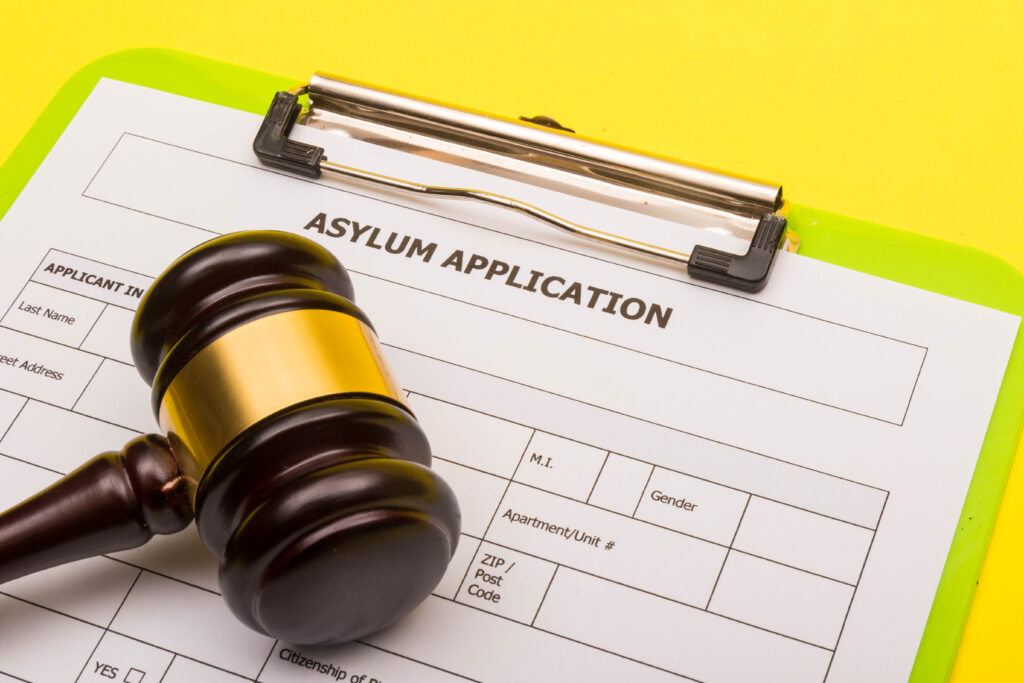For individuals fleeing persecution in their home countries, United States law offers a critical lifeline through the asylum process. This legal framework enables those facing serious threats due to their race, religion, nationality, political opinion, or membership in a particular social group to seek protection and rebuild their lives on American soil.
The asylum process represents more than just a legal procedure—it embodies America's commitment to providing sanctuary for those who cannot find safety in their homeland. Whether someone faces government oppression, violent persecution from non-state actors, or systemic discrimination that their government cannot or will not address, asylum offers a pathway to security and stability.
Navigating this complex legal journey requires careful preparation and understanding of each critical step. From the initial application through potential hearings and appeals, asylum seekers must present compelling evidence of their persecution while meeting strict deadlines and procedural requirements. Working with an experienced Texas immigration lawyer can make all the difference in securing protection. Success in this process can mean the difference between safety and returning to face the very dangers they sought to escape.
The Legal Foundation of Asylum

Asylum protections in the United States are governed by Section 208 of the Immigration and Nationality Act (8 U.S.C. § 1158) and its implementing regulations found in 8 C.F.R. Part 208. These laws establish the criteria for asylum eligibility and the procedures for seeking protection.
Asylum offers protection to people already in the United States who meet the definition of a refugee. A refugee is someone who has been persecuted or has a well-founded fear of persecution based on their race, religion, nationality, membership in a particular social group, or political opinion. This persecution must be by the government or groups that the government is unwilling or unable to control.
Texas, with its diverse population and proximity to the border, often sees many asylum seekers. The state's immigration courts and USCIS offices handle thousands of asylum cases annually, making it essential for applicants to understand the specific requirements and procedures that apply to their situation.
Eligibility Requirements for Asylum
To qualify for asylum in the United States, applicants must demonstrate several key elements:
Physical Presence in the United States: You must be physically present in the United States to apply for asylum, regardless of your immigration status or manner of entry. This applies whether you arrived at a port of entry with or without inspection, or are already present in the country.
Definition of Refugee: You must establish that you meet the definition of a refugee under U.S. law. This means proving either past persecution or a well-founded fear of future persecution based on one of five protected grounds.
Protected Grounds: The persecution must be based on one of the following five protected characteristics:
- Race
- Religion
- Nationality
- Membership in a particular social group
- Political opinion
Government Involvement or Acquiescence: The persecution must be by the government or by groups that the government is unwilling or unable to control. Private disputes or general violence typically do not qualify unless they relate to one of the protected grounds.
Nexus Requirement: There must be a clear connection between the persecution and one of the protected grounds. The persecution cannot be solely for personal, economic, or criminal reasons unrelated to the protected characteristics.
For example, a person might fear persecution due to their political activism against an authoritarian government, or someone might face danger because of their religious beliefs in a country where religious minorities are systematically targeted. Each case depends on specific facts and evidence, and asylum law requires a precise demonstration of how your situation fits these legal definitions.
Important Restrictions: The Circumvention of Lawful Pathways Rule
A significant development affecting asylum eligibility is the Circumvention of Lawful Pathways (CLP) rule, which went into effect on May 11, 2023. This rule creates a presumption of ineligibility for asylum for individuals who:
- Enter the United States between ports of entry along the southwest border
- Have not used designated lawful pathways to seek protection
- Cannot demonstrate they qualify for specific exceptions
Key Provisions of the CLP Rule:
The rule establishes that most individuals who cross the southwest border without authorization are presumed ineligible for asylum unless they can demonstrate one of the following exceptions:
- They sought and were denied protection in a country through which they traveled to reach the United States.
- They present themselves at a port of entry at the time of arrival.
- They used the CBP One mobile application to schedule their arrival at a port of entry.
- They qualify for the acute medical emergency exception.
- They faced an imminent and extreme threat to life or safety that prevented them from accessing lawful pathways.
Rebutting the Presumption:
While the rule creates a broad bar for most applicants who entered through the U.S.-Mexico border on or after May 11, 2023, limited exceptions do exist. Applicants subject to the rule may still seek to rebut the presumption by demonstrating exceptionally compelling circumstances that justify granting asylum despite their manner of entry.
Legal Challenges:
It's important to note that this rule has faced legal challenges. The rule's implementation and enforcement may be subject to ongoing litigation and changes.
Impact on Applications:
If you entered the United States along the southwest border after May 11, 2023, without using designated lawful pathways, you should consult with an experienced immigration attorney to understand how this rule may affect your case and what evidence might be necessary to overcome the presumption of ineligibility.
Two Primary Paths to Asylum
The asylum process in the United States operates through two distinct pathways, each with different procedures, timelines, and legal standards:
Affirmative Asylum Application
The affirmative asylum process is available to individuals who are not currently in removal proceedings before an immigration court. This process is administered by U.S. Citizenship and Immigration Services (USCIS) and involves the following steps:
Step 1: Filing Form I-589
You must complete and file Form I-589, Application for Asylum and for Withholding of Removal, along with all required supporting documentation. This form must be filed within one year of your last arrival in the United States, unless you qualify for an exception to this deadline.
Step 2: Biometrics Services Appointment
After filing your application, USCIS will schedule you for a biometrics appointment where your fingerprints, photograph, and signature will be collected for security background checks.
Step 3: Asylum Interview
A trained USCIS asylum officer will conduct a non-adversarial interview to evaluate your claim. Unlike in immigration court proceedings, you are responsible for providing your own interpreter for affirmative asylum interviews if you do not speak English fluently. The interpreter must be at least 18 years old and cannot be your attorney, witness, or representative. You may be accompanied by your attorney. The interview focuses on your personal story, the persecution you faced or fear, and the evidence supporting your claim.
Step 4: Decision
USCIS will mail you a written decision. If asylum is granted, you become an asylee with legal status in the United States. If the application is not granted, your case will typically be referred to an immigration court for removal proceedings, where you can present your case again before an immigration judge.
Defensive Asylum Application
The defensive asylum process occurs within the context of removal proceedings before an immigration court. This process is more formal and adversarial, with a Department of Homeland Security attorney arguing that you should be removed from the United States.
Step 1: Notice to Appear
The process begins when DHS issues a Notice to Appear (NTA), which formally places you in removal proceedings and specifies the reasons why the government believes you should be removed from the United States.
Step 2: Filing with Immigration Court
You must file your Form I-589 with the immigration court and serve a copy on the DHS attorney. The court will provide specific filing instructions and deadlines.
Step 3: Master Calendar Hearing
This preliminary hearing allows you to confirm receipt of the NTA, indicate what form of relief you are seeking, and request additional time to obtain legal representation if needed.
Step 4: Individual Hearing
During this formal hearing, you present your case before an immigration judge. You will testify about your persecution, present evidence, and may be cross-examined by the DHS attorney. The judge will evaluate all evidence and arguments before making a decision.
Step 5: Decision and Potential Appeal
The immigration judge will issue a written decision. If asylum is granted, you receive legal status. If denied, you may face removal from the United States, though you may have the right to appeal the decision to the Board of Immigration Appeals.
Critical Deadlines and Requirements
Several important deadlines and requirements can significantly impact your asylum case:
The One-Year Filing Deadline

Under 8 C.F.R. § 208.4, asylum applications must generally be filed within one year of your last arrival in the United States. However, there are two important exceptions:
Changed Circumstances: Significant changes in your country of origin or your personal circumstances that materially affect your eligibility for asylum.
Extraordinary Circumstances: Events or factors directly related to the failure to meet the 1-year deadline, such as:
- Serious illness or mental or physical disability
- Legal disability (such as being an unaccompanied minor)
- Ineffective assistance of counsel
- Maintaining lawful immigration status
- Filing other immigration applications
Evidence and Documentation Requirements
Strong documentation is crucial for asylum cases. Relevant evidence may include:
- Country condition reports from the U.S. State Department
- Medical records documenting physical or psychological harm
- Police reports or court documents
- Witness statements and affidavits
- News articles or other media reports
- Expert testimony about country conditions
All foreign documents must be translated into English by a certified translator, and the authenticity of documents may be scrutinized during the proceedings.
Credibility Standards
Your testimony must be credible, detailed, and consistent throughout the process. Immigration judges and asylum officers are trained to evaluate credibility based on factors such as:
- Consistency between your oral testimony and written statements
- Plausibility of your account
- Demeanor during testimony
- Corroboration of key facts through documentary evidence
Minor inconsistencies may be overlooked, but significant contradictions can result in denial of your application.
Work Authorization for Asylum Seekers
Asylum applicants may be eligible for employment authorization while their case is pending. Under current regulations, you may apply for an Employment Authorization Document (EAD) using Form I-765 if:
- Your asylum application has been pending for at least 150 days.
- You are not responsible for any delays in the proceedings.
- You have not been convicted of certain crimes.
In most cases, individuals who have filed for asylum and have had their Form I-589 pending for at least 150 days can apply for an employment authorization document (EAD) to legally work in the U.S.
The EAD is typically valid for one year and can be renewed as long as your asylum case remains pending.
Important Fee Change for Work Authorization
As of July 2025, there is a new $550 fee for initial work permit applications for asylum seekers. This represents a significant change from the previous policy where the first work permit for asylum seekers was free.
The fee must be submitted with your Form I-765 application. You should check the USCIS website and select "I-765" for the most current fee information before submitting an application, as fees and policies can change.
Rights and Benefits of Asylum Status
If you are granted asylum, you gain significant rights and protections:
Legal Status: You may remain in the United States indefinitely and are protected from being returned to your home country.
Work Authorization: You may work legally in the United States without restriction.
Social Security: You may apply for a Social Security number.
Travel: You may apply for a refugee travel document to travel internationally, though you generally cannot return to your home country.
Family Reunification: You may petition for your spouse and unmarried children under 21 to join you in the United States.
Path to Permanent Residence: One year after receiving asylum, you may apply for lawful permanent residence (a green card).
Frequently Asked Questions
What is the difference between asylum and refugee status?
Asylum is for individuals already in the United States or at a port of entry, while refugee status is for those seeking protection from outside the United States. Both require proving a well-founded fear of persecution based on the same five protected grounds.
Can I work while my asylum application is pending?
Yes, you may apply for work authorization 150 days after filing your asylum application, and you may receive the EAD after meeting all requirements.
What happens if my asylum application is denied?
If USCIS denies your affirmative asylum application, your case will typically be referred to immigration court. If an immigration judge denies your case, you may have the right to appeal to the Board of Immigration Appeals.
Can I include family members in my application?
To include your child as a dependent on your application, the child must be under 21 years old and unmarried. Your spouse and unmarried children under 21 who are in the United States may be included on your Form I-589.
Does my manner of entry affect my asylum eligibility?
No, you may apply for asylum regardless of how you entered the United States, including if you entered without inspection. However, the one-year filing deadline and other eligibility requirements still apply.
The Importance of Legal Representation

While legal representation is not required for asylum applications, having an experienced immigration attorney can significantly improve your chances of success. An attorney can help you:
- Understand the complex legal requirements
- Gather and organize supporting evidence
- Prepare you for interviews and hearings
- Navigate procedural requirements and deadlines
- Present your case effectively to decision-makers
The asylum process involves complex legal standards and procedures that can be difficult to navigate without professional guidance. Many successful asylum seekers work with attorneys who specialize in immigration law and have experience with asylum cases.
Seeking asylum in the United States is a complex legal process that requires careful preparation and attention to detail. Understanding the eligibility requirements, procedural steps, and critical deadlines is essential for presenting a strong case. While the process can be challenging, asylum provides a vital pathway to safety and protection for those fleeing persecution.
If you are considering applying for asylum, it is important to act quickly due to the one-year filing deadline and to seek professional legal assistance to ensure your case is properly prepared and presented. Remember that each asylum case is unique, and success depends on the specific facts and circumstances of your situation.
Seek Protection Today
Are you seeking protection through an asylum application in Texas? Bailey & Galyen stands ready to provide the aggressive, compassionate representation you need. Our team understands the critical nature of your situation. We work diligently to protect your future. Whether you need guidance from a Texas personal injury lawyer or support with immigration matters, our firm is prepared to stand by your side.
Contact Bailey & Galyen today at (817) 345-0580 for a confidential consultation. Our phones are answered 24/7, and we are prepared to help you understand your legal options.